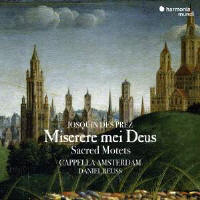Texte paru dans: / Appeared in: |
|
|
Outil de traduction ~ (Très approximatif) |
|
|
Reviewer: Barry
Brenesal As the liner notes state, this is a program of works by or about Josquin meant “to lament, to mourn, to eulogize” musicians. It begins with his most famous composition in that vein, the Déploration sur la mort d’Ockeghem, which makes use (along with the theme from his lamenting chanson, Nymphes des bois) of the Introitus Requiem aeternam of Ockeghem’s Missa pro Defunctis taken down a half step; it concludes appropriately enough with Nicolas Gombert’s Musae Jovis, which quotes Josquin’s Circumdederunt me in turn from Nymphes des bois, taken down a half step. With the exception of the motet In principio erat verbum, everything heard on this album follows thematically—even Absalon, fili mi, as it was misattributed to Josquin for centuries. (Pierre de la Rue is the current favorite.) In addition, it is a plaint placed in the mouth of the biblical David, a singer and fighter who punched above his weight. Daniel Reuss has been very active as a choral director over the years, promoting both 20th century music and that of the Renaissance. He became principal conductor of the Cappella Amsterdam in 1990, a post that, according to his website, he still holds. Their forces are 14 in number on this disc: four sopranos and basses a piece, five tenors, and one alto. This gives the group a relatively light, transparent sound, with a good solid anchor. Their small numbers help to define the individual lines of Josquin’s counterpoint. Tempos tend to the fast side of the spectrum in one-on-one comparisons—Reuss against Manfred Cordes/Weser-Renaissance Bremen (CPO 777 588-2) and Walter Testolin/De Labyrintho (Stradivarius 33862), for instance, though Testolin varies the pace more than most conductors I’ve heard in this music, drawing out phrases that could be considered today of more expressive note. I still prefer the Absalon, fili me of New York Polyphony (BIS 1949) for its predominantly dark textures and slower reading, which in turn emphasizes the work’s descending circle of fifths. Reuss secures immaculate and persuasive performances from Cappella Amsterdam, however, and they need take second place to no one. Strongly recommended. | |
|
|
|
|
Cliquez l'un ou l'autre
bouton pour découvrir bien d'autres critiques de CD |
|




